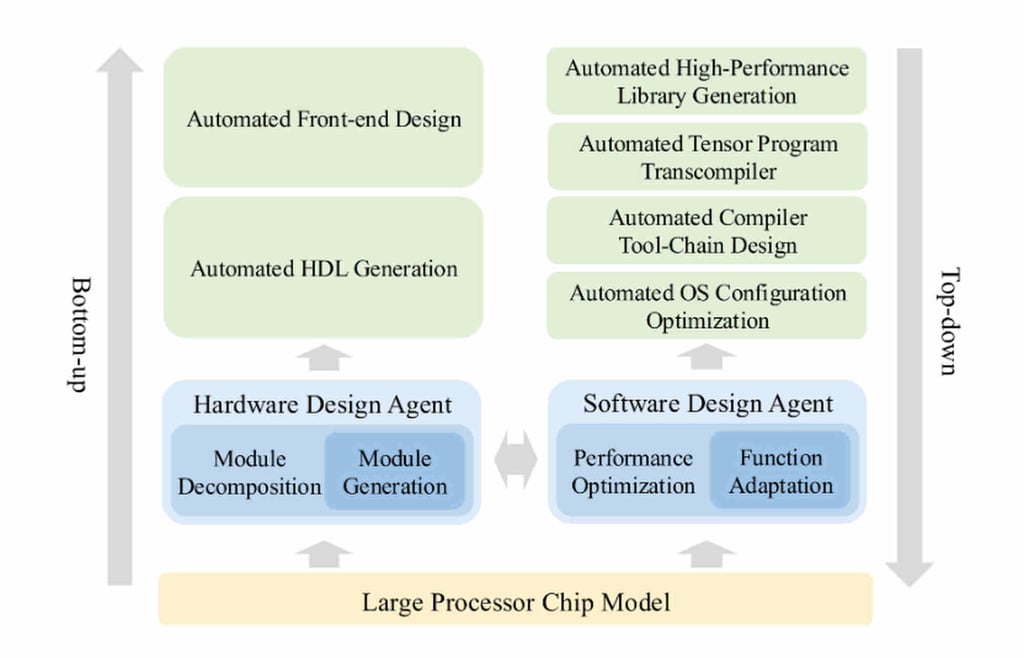The system, developed by the Chinese Academy of Sciences, uses AI for semiconductor design, dispensing with the need for human developers

The Chinese Academy of Sciences (CAS), the nation’s premier science institution, has unveiled a chip design system driven by artificial intelligence (AI) that has the potential to significantly accelerate semiconductor development and replace human programmers.
Developed by the State Key Laboratory of Processor and the Intelligent Software Research Centre, both under CAS, and the University of the Chinese Academy of Sciences, the fully automated integrated circuit design system is called QiMeng, which means “enlightenment” in Chinese.
The system uses large language models – the technology underpinning advanced AI chatbots. Details were published in a research paper last week and open-sourced on GitHub.
According to the developers, chips designed by QiMeng match the performance and efficiency of those created by human experts. A customised autonomous-driving chip, for example, which might take weeks for a team of human developers to create could be accomplished by QiMeng in just days, according to the team.

An overview of the automated chip design system QiMeng. Photo: Handout
The unveiling of QiMeng comes as the US has pressured leading electronic design automation (EDA) software suppliers to halt sales of chip design tools to China, further complicating Beijing’s goal to strengthen its semiconductor industry.
QiMeng comprises three interconnected layers: at the base is a domain-specific large processor chip model; in the middle, a hardware and software design agent; and at the top, various processor chip design applications.
These layers work in tandem to enable features such as automated front-end chip design, hardware description language generation, operating system configuration optimisation and compiler toolchain design. The research paper indicates that future updates will enhance QiMeng’s self-evolution capabilities.
Using QiMeng, researchers have designed two processors: QiMeng-CPU-v1, which they said was comparable to Intel’s 486 processor from the 1990s, and QiMeng-CPU-v2, which is similar to Arm’s Cortex A53 from the 2010s.

Sassine Ghazi, CEO of Synopsys. The US has restricted leading chip design automation software suppliers from selling to China. Photo: Reuters
The paper also highlights challenges in current chip design, including “constrained fabrication technology, limited resources and a diverse ecosystem”. QiMeng aims to automate the entire chip design and verification pipeline.
The goal was to improve efficiency, reduce costs and shorten development cycles when compared to manual methods, and to facilitate quick customisation of domain-specific chip architectures and software stacks, the developers said.
The launch of QiMeng aligns with China’s intensified push for semiconductor independence, especially as access to advanced chips – crucial for training and deploying AI models – tightens under stricter US export curbs. Chinese chipmakers currently lag industry leader Taiwan Semiconductor Manufacturing Company in advanced process node fabrication.
China also faces major hurdles in chip design software, which has been dominated by Western companies. Major EDA software suppliers, including Cadence Design Systems, Synopsys and Siemens EDA, were recently notified by the US Commerce Department regarding new export controls on their software.
The three firms accounted for a combined 82 per cent revenue share in China’s EDA market last year, according to a Morgan Stanley research note late last month.

 www.scmp.com
www.scmp.com

The Chinese Academy of Sciences (CAS), the nation’s premier science institution, has unveiled a chip design system driven by artificial intelligence (AI) that has the potential to significantly accelerate semiconductor development and replace human programmers.
Developed by the State Key Laboratory of Processor and the Intelligent Software Research Centre, both under CAS, and the University of the Chinese Academy of Sciences, the fully automated integrated circuit design system is called QiMeng, which means “enlightenment” in Chinese.
The system uses large language models – the technology underpinning advanced AI chatbots. Details were published in a research paper last week and open-sourced on GitHub.
According to the developers, chips designed by QiMeng match the performance and efficiency of those created by human experts. A customised autonomous-driving chip, for example, which might take weeks for a team of human developers to create could be accomplished by QiMeng in just days, according to the team.

An overview of the automated chip design system QiMeng. Photo: Handout
The unveiling of QiMeng comes as the US has pressured leading electronic design automation (EDA) software suppliers to halt sales of chip design tools to China, further complicating Beijing’s goal to strengthen its semiconductor industry.
QiMeng comprises three interconnected layers: at the base is a domain-specific large processor chip model; in the middle, a hardware and software design agent; and at the top, various processor chip design applications.
These layers work in tandem to enable features such as automated front-end chip design, hardware description language generation, operating system configuration optimisation and compiler toolchain design. The research paper indicates that future updates will enhance QiMeng’s self-evolution capabilities.
Using QiMeng, researchers have designed two processors: QiMeng-CPU-v1, which they said was comparable to Intel’s 486 processor from the 1990s, and QiMeng-CPU-v2, which is similar to Arm’s Cortex A53 from the 2010s.

Sassine Ghazi, CEO of Synopsys. The US has restricted leading chip design automation software suppliers from selling to China. Photo: Reuters
The paper also highlights challenges in current chip design, including “constrained fabrication technology, limited resources and a diverse ecosystem”. QiMeng aims to automate the entire chip design and verification pipeline.
The goal was to improve efficiency, reduce costs and shorten development cycles when compared to manual methods, and to facilitate quick customisation of domain-specific chip architectures and software stacks, the developers said.
The launch of QiMeng aligns with China’s intensified push for semiconductor independence, especially as access to advanced chips – crucial for training and deploying AI models – tightens under stricter US export curbs. Chinese chipmakers currently lag industry leader Taiwan Semiconductor Manufacturing Company in advanced process node fabrication.
China also faces major hurdles in chip design software, which has been dominated by Western companies. Major EDA software suppliers, including Cadence Design Systems, Synopsys and Siemens EDA, were recently notified by the US Commerce Department regarding new export controls on their software.
The three firms accounted for a combined 82 per cent revenue share in China’s EDA market last year, according to a Morgan Stanley research note late last month.

Chinese academy launches automated system to speed up chip design
The system, developed by the Chinese Academy of Sciences, uses AI for semiconductor design, dispensing with the need for human developers.
